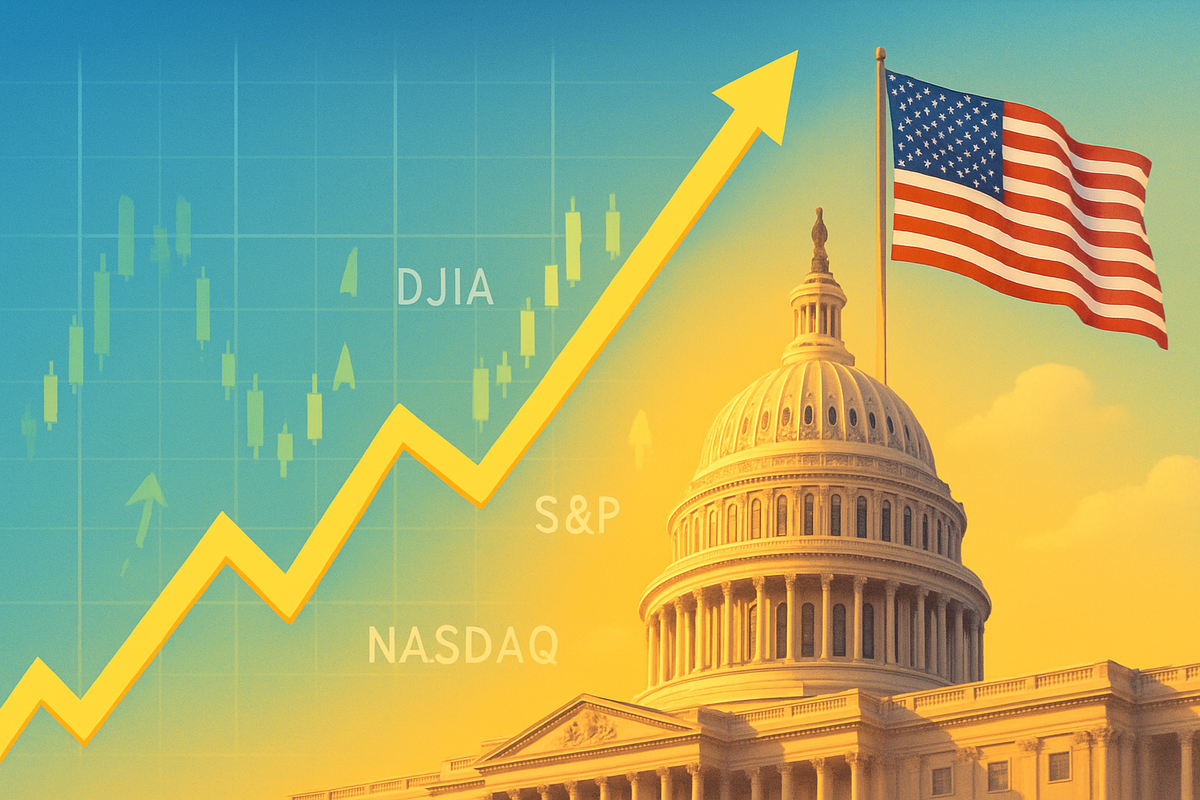
The United States stock market is experiencing a robust rally, fueled by a wave of optimism surrounding the anticipated end of the longest government shutdown in the nation's history. As of November 12, 2025, major indices like the Dow Jones Industrial Average (Dow), S&P 500, and Nasdaq Composite are showing significant gains, reflecting investor relief and renewed confidence that federal operations will soon normalize. This positive market sentiment comes after weeks of political deadlock, which saw critical government functions curtailed and economic data delayed, creating an environment of uncertainty for businesses and consumers alike. The market's immediate reaction underscores a collective sigh of relief, with investors betting on a swift return to stability and the unfreezing of economic activity.
The rally is a direct response to progress in Congress towards a bipartisan agreement to reopen the government. This development is expected to alleviate the economic drag caused by the shutdown and allow for the release of crucial economic indicators, providing a clearer picture of the nation's financial health. While the immediate implications are overwhelmingly positive, market participants are also closely watching for any lingering effects of the prolonged closure and the potential for future political impasses.
A Nation Holds Its Breath: The Shutdown's End and Market's Ascent
The federal government entered a shutdown on October 1, 2025, after Congress failed to pass appropriations legislation for the 2026 fiscal year. This impasse, extending over 40 days, became the longest government shutdown in U.S. history, surpassing the 34-day shutdown of 2018-2019. The closure led to the furlough of approximately 900,000 federal employees and left another two million working without pay, disrupting a wide array of government functions from national park services to critical regulatory approvals and the processing of small business loans.
Optimism for a government reopening surged in early November 2025. On Sunday, November 9, a bipartisan group in the Senate advanced a bill aimed at reopening the government. This temporary continuing resolution (CR), passed by the Senate on Monday, November 10, with a 60-40 vote, is widely expected to be approved by the House of Representatives on Wednesday, November 12, and subsequently signed into law by President Trump. The proposed bill would provide full-year funding for some government departments and fund other agencies through January 30, 2026, crucially including provisions for back pay for furloughed federal workers.
The prospect of an end to the shutdown immediately sparked a "risk-on mood" across asset markets. Robust third-quarter corporate earnings also contributed to the positive sentiment, with approximately 82% of S&P 500 companies exceeding forecasts. As of November 12, 2025, the Dow Jones Industrial Average (Dow) jumped over 550 points on Tuesday, November 11, reaching a new record high. The S&P 500 saw substantial increases, climbing 1.54% on Monday, November 10, and closing just shy of 6,850 on Tuesday. The tech-heavy Nasdaq Composite (Nasdaq) initially rallied strongly, gaining 2.27% on Monday, November 10, though it showed mixed performance on Tuesday, attributed to weakness in AI-infrastructure stocks and semiconductor makers like Nvidia (NASDAQ: NVDA) after SoftBank Group sold its entire stake. The market's reaction also included a rotation of investment, with traders moving into "blue chip and cyclical names" on expectations of a funding deal.
Winners and Losers: Corporate Fortunes in the Wake of Reopening
The end of the government shutdown will undoubtedly reshape the landscape for numerous public companies, creating both immediate beneficiaries and those facing lingering challenges. Sectors heavily reliant on federal funding, contracts, or permits are poised for a significant rebound, while others may contend with the aftermath of prolonged disruptions.
Companies and Sectors Poised to Win:
- Government Contractors: Large government contractors are the most direct beneficiaries. Companies like Science Applications International Corp (NYSE: SAIC) and Leidos (NYSE: LDOS) will see a resumption of paused contracts, lifting of stop-work orders, and the initiation of new project awards. Major defense firms such as RTX (NYSE: RTX), Lockheed Martin (NYSE: LMT), and General Dynamics (NYSE: GD), whose essential programs are often more insulated, will benefit from renewed stability in contract negotiations and awards. Their revenues are expected to rebound as delayed payments are processed.
- Travel and Tourism: With federal agencies reopening, air traffic control staff fatigue and safety concerns will gradually ease, and national parks and other federal attractions will fully reopen. This will lead to a significant rebound in travel spending, especially as furloughed federal employees receive back pay. Airlines like Delta Air Lines (NYSE: DAL) and American Airlines (NASDAQ: AAL), along with hotel chains such as Marriott International (NASDAQ: MAR) and Hilton Worldwide Holdings (NYSE: HLT), particularly those near federal hubs or tourist destinations, are expected to see increased demand.
- Financial Services: The Small Business Administration (SBA) will resume processing loans, clearing a substantial backlog. Mortgage applications delayed due to income verification for federal workers will also proceed. Banks and credit unions involved in SBA lending will see a resumption of loan originations and related fee income, benefiting institutions with significant small business lending exposure.
Companies and Sectors Facing Lingering Challenges:
- Small Government Contractors: Unlike their larger counterparts, many small businesses often lack the liquidity to sustain operations without payment during a shutdown and are typically not guaranteed back pay for services rendered. This can lead to permanent revenue loss, layoffs, or even business closures, making their recovery more arduous.
- Aviation Infrastructure and Regulatory Services: While airlines will recover, the Federal Aviation Administration (FAA) faces significant backlogs in aircraft certification, safety inspections, and air traffic controller hiring. A prolonged shutdown could exacerbate existing shortages, potentially impacting holiday travel and delaying growth for companies whose operational efficiency is tied to FAA regulatory processes.
- Industries Requiring Federal Permits and Approvals: Sectors like environmental, energy, and pharmaceuticals, which depend on timely permits, licenses, and regulatory reviews from agencies like the EPA and FDA, will encounter significant backlogs. Delays in critical approvals can push back revenue streams and increase operational costs for companies with major projects or product pipelines awaiting federal sign-off.
- Local Consumer-Facing Businesses (Lingering Effects): While a rebound in consumer spending is expected, some smaller businesses in areas with large federal workforces may have already suffered irreversible damage from weeks of reduced traffic and revenue, potentially leading to permanent closures.
Beyond the Immediate: Unpacking the Wider Significance
The reopening of the U.S. government, especially after a prolonged impasse, carries a wider significance that transcends the immediate market reaction. It represents a critical restoration of stability and predictability in federal operations, which are foundational to the broader economy, international relations, and the regulatory environment.
Historically, the U.S. stock market has shown remarkable resilience to government shutdowns, with major indices often posting positive returns in the months following a resolution. While short-term volatility may increase during a shutdown, broader economic factors like corporate earnings, interest rates, and the outlook for economic growth generally exert a greater influence on long-term market performance. The end of this shutdown alleviates the "fog" created by the halt in critical economic data releases, allowing the Federal Reserve, businesses, and investors to make more informed decisions.
The ripple effects extend globally. Delays in customs, export licensing, and inspections during the shutdown disrupted international trade and supply chains, affecting manufacturers and distributors worldwide. A reopening unblocks these chokepoints, restoring the efficiency of global trade. Furthermore, repeated shutdowns can erode international investor confidence, potentially prompting a reallocation of capital away from U.S. assets. A reopening helps to reaffirm the U.S.'s image as a stable economic environment, though frequent impasses may still leave a lingering perception of political risk.
Regulatory and policy implications are also substantial. Federal agencies will face significant backlogs in processing permits, licenses, and regulatory filings. Businesses with reporting obligations should anticipate bottlenecks. Agencies may also attempt to make up for lost time by accelerating rulemaking agendas, potentially using quicker regulatory actions. The resolution of the shutdown also brings back into focus the legislative and policy priorities that led to the impasse, such as ongoing debates around the expiration of Affordable Care Act (ACA) subsidies, indicating that these areas could see immediate attention.
What Comes Next: Navigating the Post-Shutdown Landscape
The conclusion of the government shutdown ushers in a new phase for the U.S. economy and markets, marked by both opportunities for recovery and persistent challenges. The short-term will likely see a burst of activity as backlogs are cleared and consumer spending, bolstered by federal employees' back pay, rebounds. However, the long-term outlook suggests a more nuanced recovery.
In the short term, the resumption of federal services will gradually bring normalcy, and the injection of back pay will stimulate local economies. The initial market rally is a clear indicator of reduced uncertainty. However, lingering disruptions, particularly in areas like air travel due to exacerbated air traffic control shortages, could persist for weeks or even months. The delayed release of critical economic data will also be a key factor, as its eventual publication could influence Federal Reserve policy decisions and market sentiment.
Looking further ahead, the prolonged shutdown is projected to result in a permanent loss of a portion of the Gross Domestic Product (GDP), estimated to be billions of dollars in economic activity for the fourth quarter of 2025. This, coupled with potential damage to federal employee morale and possible attrition, could create a lingering drag on productivity and hiring into early 2026. Moreover, if the underlying budgetary and political disagreements that led to the shutdown are not fundamentally resolved, the risk of future impasses remains, potentially leading to entrenched political dysfunction and sustained erosion of confidence.
Businesses will need to implement strategic pivots. Diversifying revenue streams beyond government contracts, building financial resilience with robust cash reserves, and engaging in proactive scenario planning are crucial. For government agencies, the focus will be on efficiently clearing backlogs, restoring IT systems, and reassessing staffing needs.
Market opportunities may arise from a continued "risk-on" sentiment and increased consumer spending. Fintech solutions that provided support during the shutdown might also see continued growth. However, challenges include the uncertainty surrounding delayed economic data, existing economic headwinds like sluggish hiring and elevated inflation, and the vulnerabilities of small businesses. Regulatory backlogs will also present ongoing hurdles for regulated industries. The most probable scenario is a fragile recovery with lingering effects, where while the government reopens, the full return to pre-shutdown efficiency takes time, and underlying political tensions persist.
The Road Ahead: A Market in Transition
The end of the U.S. government shutdown, a pivotal event on November 12, 2025, marks a significant turning point for the financial markets and the broader economy. The immediate relief rally across major indices like the Dow, S&P 500, and Nasdaq underscores the market's aversion to uncertainty and its inherent optimism for stability. Key takeaways include the resilience of the stock market in the face of political gridlock, the critical role of government operations in underpinning economic activity, and the varied impact on different sectors and companies.
Moving forward, investors should watch for the complete release of delayed economic data, which will provide a clearer picture of the economy's health and likely influence the Federal Reserve's monetary policy decisions, particularly regarding potential rate cuts. The efficiency with which federal agencies clear their backlogs will also be crucial for businesses reliant on permits, approvals, and contracts.
While the immediate future appears brighter, the lasting impact of this prolonged shutdown will be a subject of careful analysis. The episode highlights the need for businesses to build greater resilience against political volatility and for policymakers to seek more sustainable solutions to budgetary disagreements. The market will continue to assess not just the economic fallout, but also the political will to prevent future shutdowns, which could have a more profound and lasting effect on confidence and long-term investment.
This content is intended for informational purposes only and is not financial advice





